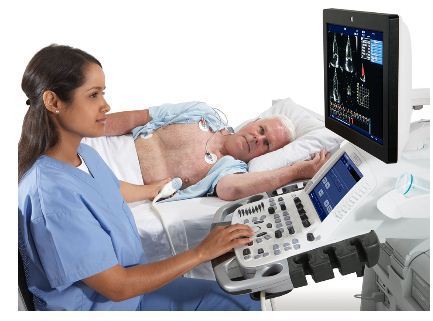2-D Echocardiography
What Is 2-D Echocardiogram? - By Dr. Kedar Kulkarni
Dr. Kedar Kulkarni, a well-known cardiologist in Pune explained about 2-D Echocardiogram, its Preparation and Procedure, uses risks and after-effects.
2-D Echocardiogram is a safe and painless procedure that uses a transducer (a small, microphone-type device) to send high-frequency sound waves to the heart. The technologist can view the heart valves and pumping strength, look for structural defects, heart enlargement, and/or fluid buildup. A Doppler exam and Color Flow exam are also performed. This allows doctors to evaluate blood flow through the heart. The technologist will videotape parts of the study for later diagnosis by the cardiologist.

Preparation and Procedure
- You will lie on your back and left side.
- Electrodes (small, adhesive patches) will be attached to your chest to record your heart’s electrical activity (EKG) during the test.
- The gel will be applied to your chest.
- The transducer will be placed on your skin and moved around the area to view the heart from different angles.
- Wear clothing that is easy to remove from the waist up.
- Avoid the use of creams and lotions on the chest area
- There are no diet restrictions
- Please bring a list of medications with you.
Uses
Your doctor may order an echocardiogram for several reasons. For example, they may have discovered an abnormality from other testing or while listening to your heartbeat through a stethoscope. If you have an irregular heartbeat, your doctor may want to inspect the heart valves or chambers or check your heart’s ability to pump. They may also order one if you’re showing signs of heart problems, such as chest pain or shortness of breath.
Risks
Echocardiograms are considered very safe. Unlike other imaging techniques, such as X-rays, echocardiograms don’t use radiation.
A transthoracic echocardiogram carries no risk. There’s a chance for slight discomfort when the electrodes are removed from your skin. This may feel similar to pulling off a Band-Aid.
There’s a rare chance the tube used in a transesophageal echocardiogram may scrape the side of your esophagus and cause irritation. The most common side effect is a sore throat. You may also feel a bit funny due to the sedative used in the procedure.
The medication or exercise used to get your heart rate up in a stress echocardiogram could temporarily cause an irregular heartbeat. The risk of a serious reaction is reduced because the procedure is supervised.
After a 2 - D Echocardiogram
Your doctor will review your results after the test. The results may reveal abnormalities such as:
- Damage to the heart muscle
- Heart defects
- Heart size
- Pumping strength
- Valve problems
